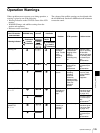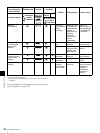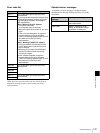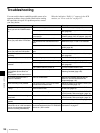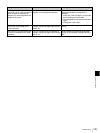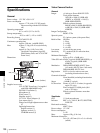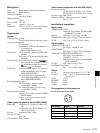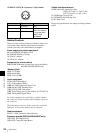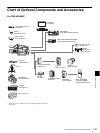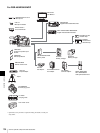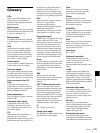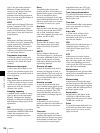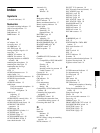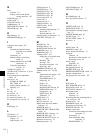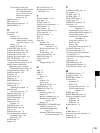
135
Glossary
Chapter 7 Appendix
Glossary
ATW
Auto Tracing White balance. The
white balance is automatically
adjusted for the lighting conditions
during shooting.
Bayonet type
A type of lens mount. The lens can be
inserted into the lens mount and fixed
in place by rotating a ring.
Black balance
To balance the black level of the R,
G, and B signals so that black has no
color.
CCD
Abbreviation for charge-coupled
device. A semiconductor used in
place of a camera tube. The CCD
converts light into electrical charge,
and outputs the electrical charge in
the form of varying voltages.
Center marker
A cross on the viewfinder screen that
indicates the center of an image.
Color bar signals
Test signals displayed on the screen
as multicolored vertical stripes. Used
for adjustment of hue, and saturation
of a video camera and video monitor.
Color conversion filter (CC
filter)
A filter that converts the color
temperature to a reference value so
the same picture tone is obtained in
different lighting conditions.
Color temperature
The color quality of light, expressed
in Kelvin (K).
Composite video signal
A signal that consists of video
(luminance and color sub carrier),
sync (horizontal and vertical), and
color burst signals.
CTL
Abbreviation for control signal. A
signal that you can count to
determine the number of frames, and
therefore the tape's running time. It is
used mainly to adjust the tracking
position of video heads, and to
achieve time code continuity when
recording continuously. This signal is
recorded in a longitudinal tape track.
DCC
Abbreviation for dynamic contrast
control. In a high contrast
environment, this function
compresses the high light signal by
adjusting the knee point
automatically, allowing you to take
clear pictures in a dynamic range.
Drop frame mode
SMPTE time code runs at 30 frames/
second, while the NTSC color
television system runs at about 29.97
frames/second. Drop frame mode
adjusts the running of time code to
eliminate the discrepancy between
time code value and actual time by
dropping two frames from the time
code value at the beginning of each
minute except every tenth minute.
Drum
A metal cylinder to which the video
heads are attached. During recording
and playback, the drum rotates at
high speed in synchronization with a
control signal.
EBU
Abbreviation for European
Broadcasting Union. A professional
broadcasting establishment in
Europe.
EXT TC (External time code)
A time code input from external
equipment together with audio data.
It corresponds to the conventional
time code recorded on tape based
media. Instead the EXT TC is usually
used to record time codes and audio
signals that are played back by
equipment that is not synchronized
with the reference video signal.
Ff
See “Flange focal length”.
Flange focal length
The length between the objective lens
and the surface of the imager.
Flare
The loss of contrast in an image
caused by unnecessary light that
strays into the image plane.
Flicker
Repeated changes in screen
brightness caused by an interference
between the camera's scanning and
the lighting conditions.
GENLOCK
A state in which devices are locked to
a signal output by a sync generator.
Genlock allows multiple devices to
operate in synchronization.
HAD
Abbreviation for hole-accumulated
diode. A CCD sensor structure
designed to suppress certain types of
noise inherent to CCDs.
Head drum
See “Drum”.
Horizontal resolution
The horizontal resolution of the
screen, which is expressed as the
number of vertical lines
distinguishable when shooting a test
chart.
i.LINK
Another name for the IEEE1394-
1995 standards and their revisions.
XDCAM uses the i.LINK interface to
transfer DV streams by the AV/C
protocol, and toread and write MPEG
IMX and DVCAM data files by FAM
(File Access Mode).
Interlaced scan mode
A scanning method in which odd
rows fields are read alternately with
even rows. (Odd-row fields and
evenrow fields contain images from
different times.)
ND filter
Abbreviation for neutral density
filter. A filter that reduces the amount
of incident light equally across the
entire visible wavelength range
without affecting color.
Non-drop frame mode
A mode of advancing time code
which ignores the difference in frame
values between real time and the time



